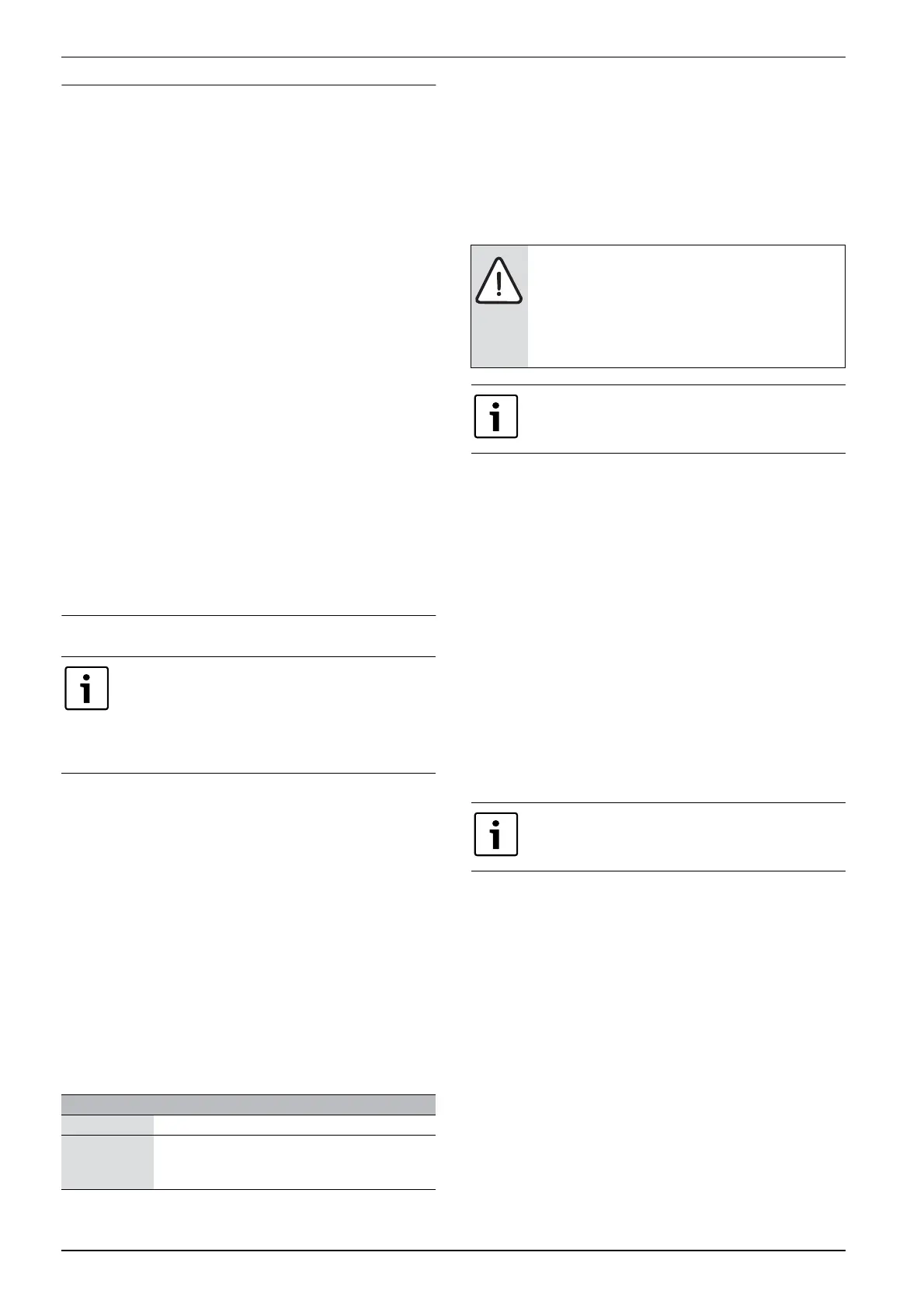Heat pump module components replacement
AirModule 6 720 813 268(2014/10)
58
15 Heat pump module components replacement
1. Disconnect the heat pump and heat pump module power.
2. Check that automatic ventilation is active on VL1.
3. Close the heating system valves; particle filter SC1 and VC1.
4. Connect one end of a hose to VC0 and the other end to a drain. Open
the drain valve VC0.
5. Wait until the water has stopped flowing to the drain.
6. Replace the components.
7. Open the fill valve VW2 to fill the heat pump pipes.
8. Continue filling until only water comes out of the hose by the drain
and the outdoor unit's condenser does not form bubbles any more.
9. Close the drain valve VC0 and continue filling until the pressure
gauge GC1 shows 2 bar.
10.Close the fill valve VW2.
11.Connect the heat pump and heat pump module power.
12.Remove the hose from the drain valve VC1.
13.Activate the booster heater only and ensure that the DHW circulation
pump PC1 is running.
14.Remove the PC0 PWM plug from the circulation pump PC0 so that it
operates at maximum speed.
15.Only deactivate the booster heater when the pressure has not
dropped in 10 minutes.
16.Connect the PC0 PWM plug to the circulation pump.
17.Clean the particle filter SC1.
18.Open the heating system valve: VC1 and particle filter SC1.
19.Check the pressure after a while and add more with the fill valve VW2
if the pressure is below required pressure.
16 Function check
▶ System commissioning as described in Chapter 11.
▶ Vent the system as described in Chapter 14.
▶ Test active system components as described in Chapter 12.9.1.
▶ Check that the heat pump commissioning requirements have been
fulfilled.
▶ Check that there is a heating or a DHW demand.
-or-
▶ Create a demand either by running the hot water or by raising the
heating curve (if the outside temperature is high, you can optionally
also modify the setting for Heating mode from).
▶ Check that the heat pump starts.
▶ Check that there are no Current alarms according to Chapter 12.9.3.
-or-
▶ Solve operating errors according to Chapter 13.
▶ Check operating temperatures according to Chapter 16.3.
16.1 Set heating system operating pressure
▶ Fill to 2 bar unless stated otherwise.
▶ If there is a pressure drop: check the expansion vessel and heating
system for leaks.
16.2 Pressure switch and overheating protection
The pressure switch and the overheating protection are connected in
serial, so that a tripped alarm or information in the user interface means
either that the system pressure is too low, or that the immersion heater
temperature is too high.
Pressure switch
The heat pump module is equipped with a pressure switch, which is
tripped when the heating system pressure is below 0.5 bar. The
pressure switch will reset itself when the pressure is above 0.5 bar.
▶ Check that the expansion vessel and the pressure relief valve have
the required pressure for the installation.
▶ Check for leaks in the system.
▶ Slowly increase the heating system pressure by adding water
through the fill valve.
Overheating protection
The overheating protection is tripped if the immersion heater
temperature is above 95 °C.
▶ Check the system pressure.
▶ Check the heating and DHW settings.
▶ Reset the overheating protection by pressing the button at the
bottom of the electric box ( [3], fig. 22).
16.3 Operating temperatures
For optimal operation of the installation it is important that the heat
pump and heating system flow is checked. This check should be
performed after 10 minutes heat pump operating time and during high
compressor heating output.
The temperature differential over the heat pump should be set for
different heating systems ( Chapter 12.1.1),
▶ For underfloor heating system; set the heating temp. diff. to 5 K.
▶ For radiators; set the heating temp. diff. to 8 K.
These settings are optimal for the heat pump.
Check the temperature differential during high compressor heating
output:
▶ Go to the Diagnostics menu.
▶ Select Monitored values.
▶ Select Heat pump.
▶ Select Temperatures.
The compressor in the heat pump warms up before it
starts. This can take up to 2 hours, depending on the
outside temperature. The requirement is that the
compressor temperature is 10 K above the air intake
temperature. The temperatures are visible in the
Diagnostics menu ( Chapter 12.9).
Indication on pressure gauge
1 bar Minimum system pressure (when cold)
2.5 bar Maximum filling pressure at max. temperature of the
heating water: may not be exceeded (safety valve
opens).
Table 42 Operating pressure
NOTICE: Risk of damage due to dry run!
The heat transfer pump PC0 can get damaged if it
operates for a longer period of time with insufficient
pressure in the system.
▶ Repair any leaks in the system if the pressure switch
is tripped.
Tripped pressure switch only blocks the immersion
heater. The circulation pump PC0 and the heat pump can
continue to operate in case of risk of freezing.
The operating temperature check must be performed in
heating mode (not in DHW or cooling mode).
